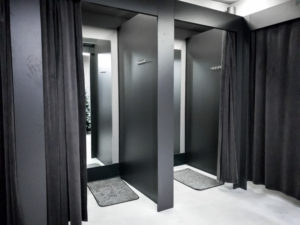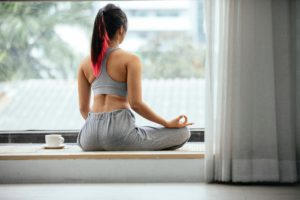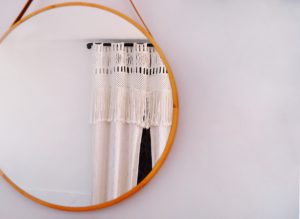Skinny Mirrors, Mirror Meditation, and What They Say about Body Image
|
April 22, 2022
|
8 Comments
|
On today’s episode of That Can’t Be Real: Have you heard of skinny mirrors? For those of us who have run through a funhouse, we know our reflection can get seriously warped depending on the surface. Like, it can go from zero to Pixar-mom hips real quick. But when we’re trying on clothes in a store dressing room, we expect what we see to be what we get—until it’s not.
What are Skinny Mirrors?

With Belinda Jasmine’s Skinny Mirror, people see a leaned-out version of themselves that appears 5-10 pounds slimmer—so like the opposite of a Hollywood camera. She launched her business to boost people’s self-confidence as they’re getting ready in the mornings, but soon retailers joined her client list. Why? To no surprise, people are more likely to buy clothes they think they look better in—even if it’s not the clothes doing the work.
Learning all this sent me to the immediate thought of, “Wow, that sounds unhealthy.” And a lot of people had the same reaction, which is why she closed up shop in 2018 following backlash. At the time, Belinda assured the public that each skinny mirror for home use had a logo reminding customers that they were looking into an IRL Instagram filter. Even if these illusion devices are out of circulation, the questions they sparked are still pressing today:
Why do we feel the way we do in front of mirrors? Why is Mulan’s Reflection the only one we 100% stan? I didn’t do so hot in my undergrad philosophy course, so I have no idea. But who does have some insight is Dr. Tara Well, a psychology professor at Columbia University who has spent years studying our relationship with mirrors—and oh, what a complicated one it is.
What’s our Deal with Mirrors?

First off, if you loathe staring at yourself for an hour during your makeup routine, blame biology. According to Dr. Well, humans have developed a negativity bias over time that highlights perceived imperfections while glossing over features we actually like. “That based on evolution, because we’re always looking for things about ourselves that could lead to social rejection,” she says. “It was very important in ancient times to be part of a group, so things that are unusual get our attention really quickly.” Of course, what counts as unusual depends on who you ask—and when you ask it—since beauty standards are as wishy-washy as a Tinder match.
But even if a thicker waist and (gasp!) touching thighs are ringing your internal alarm circa 2022, these so-called flaws probably aren’t garnering the same level of scrutiny from others. Our primate brains analyze our traits since they were “threats” of ostracization forever ago, but the barista at Starbucks doesn’t have the same survival instinct when it comes to the shape of our Cupid’s bow. To put it finely, there’s some science behind the saying, “You’re your own worst critic.” In some cases, this hypercriticism of an aspect of our appearance can escalate to body dysmorphic disorder (BDD), which can also lead to feeling anxious in social settings.
What is Mirror Meditation?

While certain medications and cognitive therapy can help treat BDD, Dr. Well says mirror meditation—which is exactly what it sounds like—could also reset the harmful cycle of: look at reflection, judge, repeat. She even wrote a book that goes into the nitty-gritty neuroscience behind our brains and those pre-party checks that can either make or break our mood. “The idea is to change your association so that when you start to feel socially anxious, you take a glance in the mirror and remember, ‘I have compassion for myself. I accept myself for who I am,’ rather than looking in the mirror and going, ‘Oh my God, I look so old; I look so fat; I don’t look as pretty as other women here’—or whatever it is your standard storyline is,” Dr. Well explains.
I’m not going to pretend it doesn’t seem completely backward to sit in front of the very object that makes us squirm, but Dr. Well’s studies affirm that meditating mano a mirror helps us identify how quickly we are to self-judge, reveals our true emotional state as it’s written on our face, and, after we get comfortable with the practice, builds confidence and comfortability in our own skin.
How do you mirror meditate?

It’s not that hard to test out. Just grab a mirror, watch the most beautiful thing in the world (aka you!) for 10 minutes, and see what happens. (Sidenote: If eye contact with yourself feels weird, you can always focus on your chest rising with your breath instead.) Most importantly, don’t try to “do” something. At the start, your only goal is to observe how your body and mind respond. Does your thinking go straight to nit-picking? Do you feel uncomfortable or powerful or strangely intimate?
The answers to these questions could shed light on some hidden insecurities, which you can then work to dispel. Once you tackle that tiny irritation at the way your nose curves or shoulders slope, you hopefully won’t need a Skinny Mirror to feel like your best self in the morning. That’s ultimately the goal, right? Because just the phrase “skinny mirror” still makes me feel like I’m in the world of Black Mirror—which is somewhere I’d really prefer to avoid.

Source by www.blogilates.com


